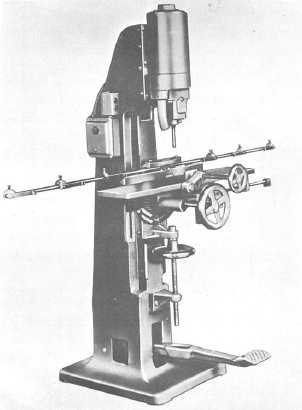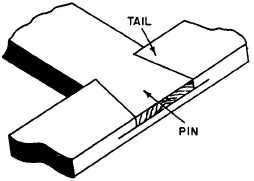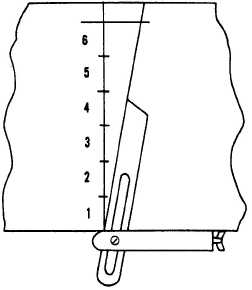
Figure 3-59.-Hollow-chisel mortising machine.
Mortises are cut mechanically on a hollow-chisel mortising machine like the one shown in figure 3-59. The cutting mechanism on this machine consists of a boring bit encased in a square, hollow, steel chisel. As the mechanism is pressed into the wood, the bit takes out most of the waste while the chisel pares the sides of the mortise square. Chisels come in various sizes, with corresponding sizes of bits to match. If a mortising machine is not available, the same results can be attained by using a simple drill press to take out most of the waste and a hand chisel, for paring the sides square.
In some mortise-and-tenon joints, such as those between rails and legs in tables, the tenon member is much thinner than the mortise member. Sometimes a member of this kind is too thin to shape in the customary reamer, with shoulder cuts on both faces. When this is the case, a barefaced mortise-and-tenon joint can be used. In a barefaced joint, the tenon member is shoulder cut on one side only. The cheek on the opposite side is simply a continuation of the face of the member.
Mortise-and-tenon joints are fastened with glue and with additional fasteners, as required.

Figure 3-60.-Dovetail half-lap Joint.
Dovetail Joints
The dovetail joint (figure 3-49) is the strongest of all the woodworking joints. It is used principally for joining the sides and ends of drawers in fine grades of furniture and cabinets. In the Seabee units, you will seldom use dovetail joints since they are laborious and time-consuming to make.
A through dovetail joint is a joint in which the pins pass all the way through the tail member. Where the pins pass only part way through, the member is known as a blind dovetail joint.
The simplest of the dovetail joints is the dovetail half-lap joint, shown in figure 3-60. Figure 3-61 shows how this type of joint is laid out, and figure 3- 62 shows the completed joint.

Figure 3-61.-Laying off 10 angle for dovetail joint.
Continue Reading